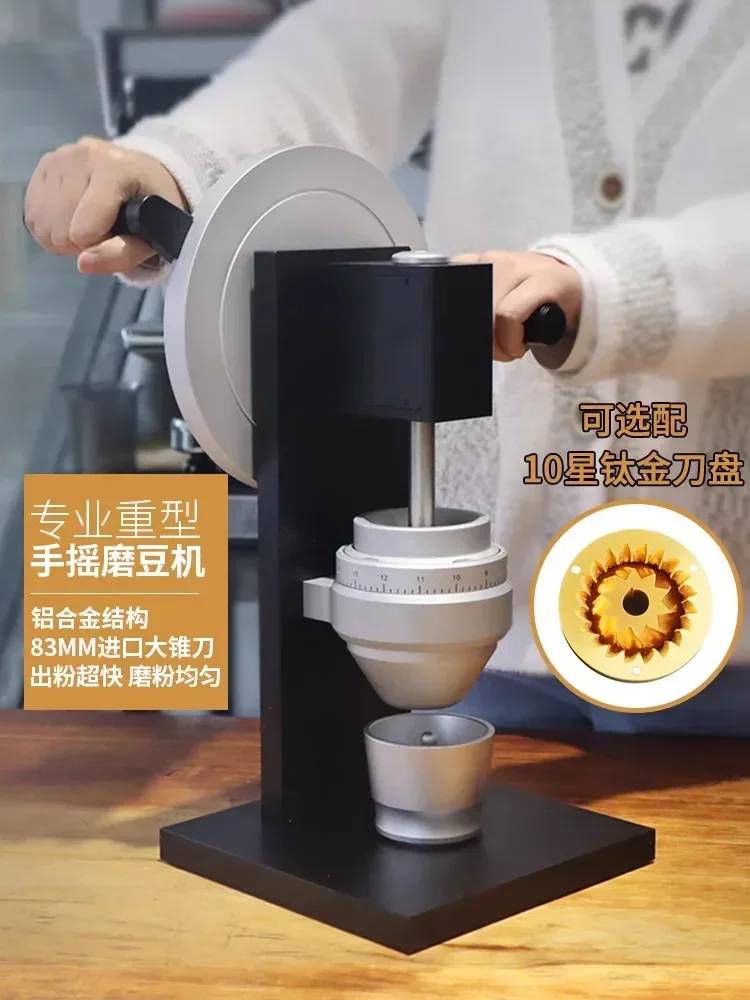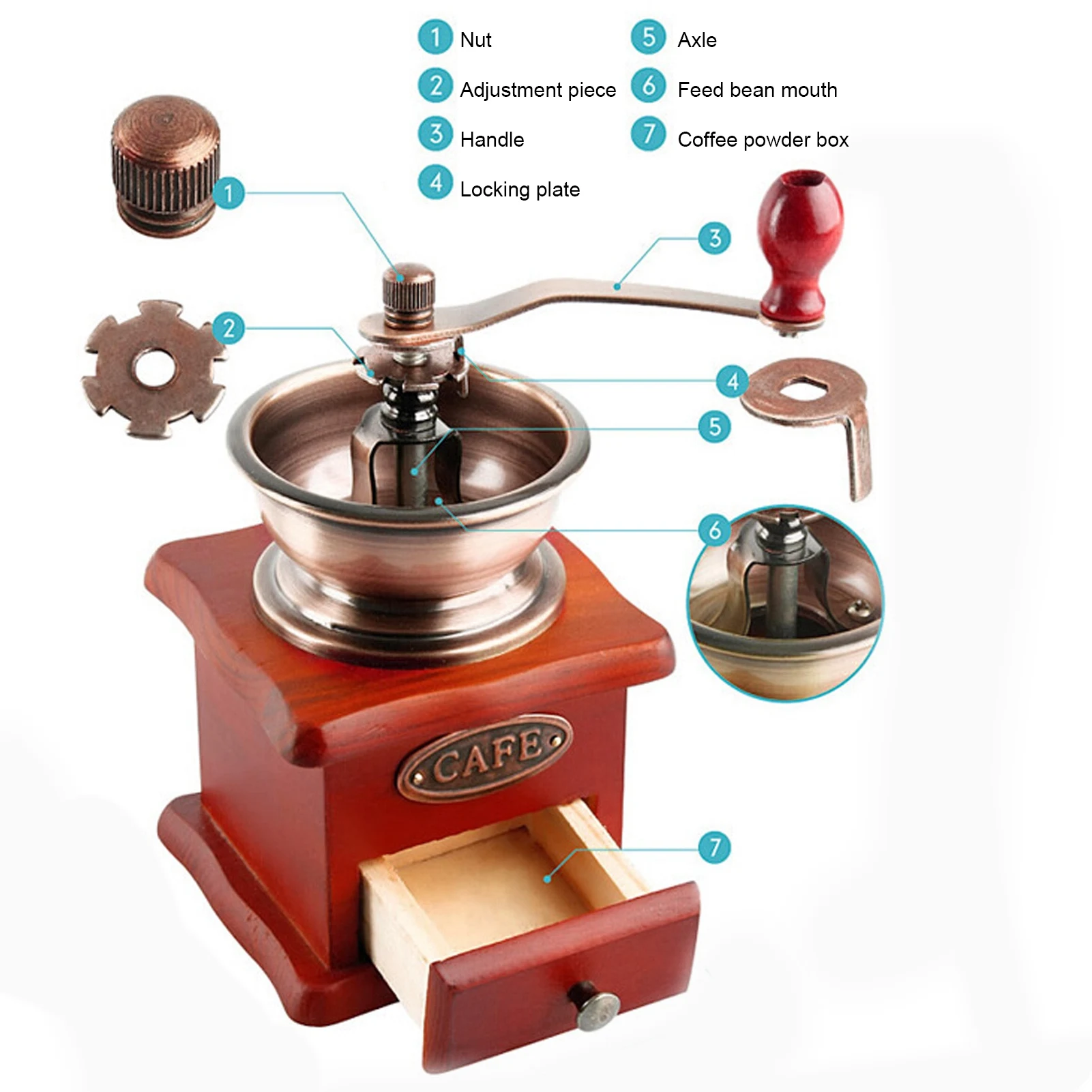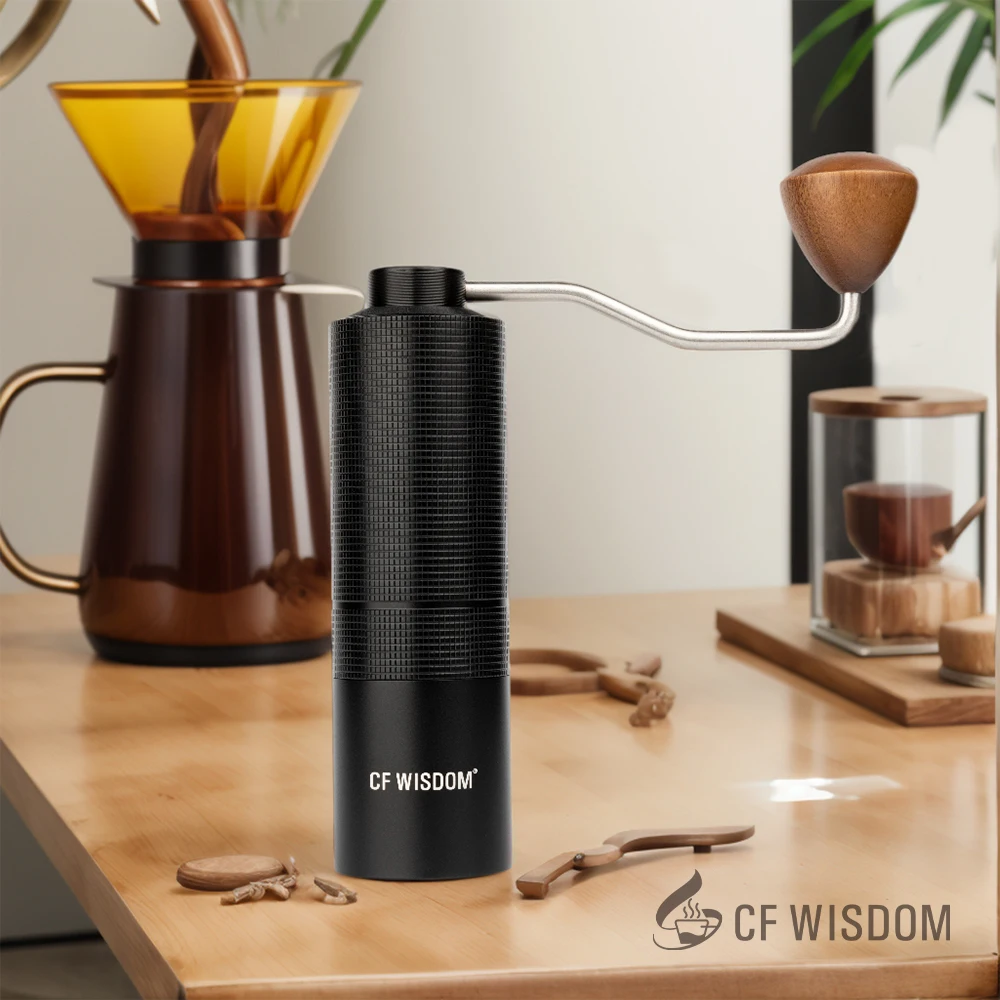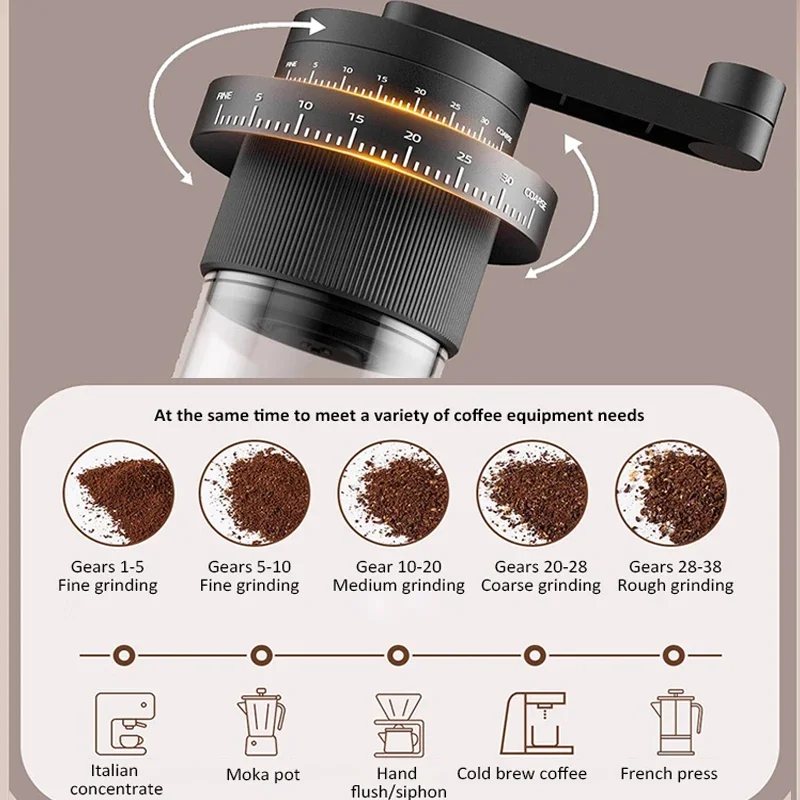Understanding Grind Consistency and Speed: The Foundational Elements
When it comes to manual coffee grinders, two factors significantly impact your brewing experience: grind consistency and grinding speed. Grind consistency refers to how uniform your coffee particles are after grinding. Think of it as having all your coffee grounds the same size – like uniform grains of sand rather than a mix of boulders and dust. This uniformity is crucial because it ensures all coffee extracts at the same rate, producing a balanced, flavorful cup.
Grinding speed, on the other hand, is simply how quickly you can turn those whole beans into ground coffee. For some coffee lovers, being able to grind 20 grams of coffee in 30 seconds versus 2 minutes makes a significant difference in their morning routine.
These two elements often work against each other in manual grinders. The pursuit of perfect consistency typically requires precision engineering that can slow down the grinding process, while faster grinding often comes at the expense of some consistency. Understanding this relationship is essential when mastering grind consistency with hand burr grinders and finding the right balance for your brewing needs.
What Makes a Grind Consistent?
Grind consistency is all about uniformity – having coffee particles that are the same size throughout your grind. Here’s why it matters:
- Even extraction: When particles are uniform, water extracts flavor from them at the same rate
- Balanced flavor: No sour notes from under-extraction or bitter notes from over-extraction
- Repeatability: You can achieve the same results brew after brew
Think of it like cooking rice – if all grains are the same size, they cook evenly. If some are broken and others whole, you end up with mush and undercooked pieces. Similarly, inconsistent coffee grounds extract unevenly. The tiny particles (fines) over-extract and create bitterness, while large chunks (boulders) under-extract and add sourness.
Different brewing methods have different consistency requirements. Espresso demands extremely uniform, fine grounds, while French press can tolerate slight inconsistency in coarser grounds. Understanding the factors affecting grind consistency helps you choose a grinder that meets your specific brewing needs.
What Determines Grinding Speed?
Grinding speed refers to how quickly you can process a certain amount of coffee beans with your manual grinder. Key aspects include:
- Time efficiency: How many seconds or minutes it takes to grind a typical dose
- Physical effort: How much force is required to turn the handle
- Comfort: How the grinding experience feels over extended use
For many coffee enthusiasts, speed becomes particularly important during daily use. While you might not mind spending extra time on a leisurely weekend morning, a grinder that takes 3 minutes of vigorous cranking every weekday morning might test your patience.
Several factors influence grinding speed, including burr size (larger burrs generally grind faster), handle length (longer handles provide more leverage), and internal mechanics. The design of the grinder, particularly the handle length and effort required in manual coffee grinders, plays a significant role in determining how quickly and comfortably you can grind your beans.
The Consistency vs. Speed Trade-Off: Understanding the Relationship
The relationship between grind consistency and speed represents one of the fundamental trade-offs in manual coffee grinder design. In most cases, as consistency improves, speed decreases – and vice versa. This happens for several mechanical reasons.
Highly consistent grinding requires precise burrs with tight tolerances, stable alignment, and often more contact points between the grinding surfaces. All these factors create more resistance during grinding, which slows down the process and requires more effort from the user. Meanwhile, grinders designed primarily for speed often use more aggressive burr designs with fewer contact points, which can process beans more quickly but might produce less uniform particles.
This isn’t just a theoretical concern – it directly affects your daily coffee experience. If you primarily brew espresso, where tiny variations in grind size dramatically impact extraction, you might prioritize consistency over speed. If you make French press coffee for multiple people each morning, you might lean toward speed since the brewing method is more forgiving of minor inconsistencies.
Understanding this fundamental balance helps you make informed decisions when selecting a grinder. While premium models often achieve better results in both areas, most grinders reflect this inherent trade-off between achieving uniform grinds in manual burrs and maintaining comfortable grinding speeds.
Key Factors Influencing Grind Consistency
The consistency of your grind depends primarily on the physical components of your manual coffee grinder. Understanding these elements helps you evaluate what makes one grinder potentially more consistent than another.
The Critical Role of Burr Quality
At the heart of every quality manual coffee grinder sits the burr set – the actual grinding mechanism that transforms whole beans into ground coffee. These burrs come in different materials and designs, each with distinct advantages:
Steel burrs cut through beans efficiently and maintain sharpness over long periods. They typically produce fewer fines (too-small particles) and work well for most brewing methods. However, they can transfer heat during extended grinding sessions.
Ceramic burrs stay cool during grinding and maintain their edge for extended periods without dulling. They’re ideal for tropical climates but can be more brittle and susceptible to damage if foreign objects enter the grinder.
The geometry of burrs also significantly affects consistency. Flat versus conical burr manual grinders produce different particle distributions. Conical burrs (most common in manual grinders) offer good consistency with less retention, while flat burrs (rare in hand grinders) can provide extremely uniform particles but require more force to turn.
The precision manufacturing of these burrs – how cleanly they’re cut, how precisely they’re shaped, and how carefully they’re matched – directly impacts grind consistency. Premium grinders feature burrs with tighter tolerances and better materials, resulting in more uniform grounds compared to ceramic versus steel grinder burrs in budget models.

Structural Stability and Alignment
Even the finest burrs can’t produce consistent grounds if they’re not properly aligned and stabilized during grinding. This is where the overall engineering of the grinder becomes crucial:
Shaft stability prevents wobbling during grinding. A shaft that shifts or flexes while you’re grinding creates inconsistent distance between the burrs, resulting in uneven particle sizes. Quality grinders use precision-machined components with tight tolerances to maintain alignment throughout the grinding process.
Bearing quality significantly impacts how smoothly the central shaft rotates. Higher-grade bearings reduce play (unwanted movement) in the shaft and maintain critical impact of burr alignment on coffee quality over years of use. Budget grinders often use plastic bushings instead of proper bearings, which can create alignment issues.
The materials used for the grinder body itself also matter. Plastic bodies may flex slightly during grinding, while metal ones (especially thicker, precision-machined aluminum or stainless steel) provide rigidity that helps maintain burr alignment under pressure.
Adjustment Precision and Control
The ability to precisely and consistently adjust your grinder is another critical factor in achieving uniform grounds:
Stepped versus stepless adjustment mechanisms offer different approaches. Stepped adjustments click into preset positions, making it easier to return to previous settings but limiting fine-tuning capability. Stepless systems allow infinite adjustment but can be harder to replicate exactly.
Adjustment retention – how well the grinder maintains its setting during use – impacts consistency between batches. Quality grinders have mechanisms that prevent settings from drifting during grinding, while budget models might shift slightly during use.
The range and precision of adjustment also vary between models. Some precision manual grinders offer exceptional control for espresso but might not adjust coarse enough for French press, while others provide excellent coarse adjustment but lack fine-tuning for espresso.
Key Factors Influencing Grinding Speed
While consistency often takes center stage in grinder discussions, speed plays an equally important role in your daily coffee routine. Several factors determine how quickly and effortlessly you can grind your coffee.
Burr Efficiency and Design for Speed
The design of the burrs themselves significantly impacts grinding speed:
Burr size makes a dramatic difference – large versus small burr grinders process different amounts of coffee per rotation. A grinder with 47mm burrs might process beans twice as fast as one with 38mm burrs, simply because the larger surface area contacts more beans per revolution.
The cutting edge design also affects efficiency. Some burrs have sharper, more aggressive cutting surfaces that slice through beans more quickly but might sacrifice some consistency. Others use more teeth with gentler cutting angles, prioritizing consistency over speed.
The feed rate – how quickly whole beans enter the grinding chamber – impacts overall speed. Well-designed manual burr mills feature hoppers and feed mechanisms that ensure a steady supply of beans to the burrs without jamming or creating bottlenecks.
Ergonomics and User Mechanics
The physical design of the grinder significantly affects how quickly and comfortably you can operate it:
Handle length provides mechanical advantage through leverage. Longer handles require less force to turn, reducing fatigue during extended grinding sessions. Many premium hand crank coffee grinders feature handles proportioned to provide optimal leverage without becoming unwieldy.
Grip comfort impacts sustainable grinding speed. An ergonomic handle with comfortable materials allows you to maintain consistent speed without hand fatigue or cramping. Some models feature wooden knobs that rotate freely, reducing friction against your palm during grinding.
Stability during use affects efficiency as well. Grinders designed to be braced against a counter or held securely between your knees allow you to apply consistent force, rather than wasting energy stabilizing a shifting grinder.
Mechanical Efficiency Elements
Beyond the burrs and ergonomics, several other mechanical factors influence grinding speed:
Bearing quality determines how smoothly the mechanism turns. High-quality bearings reduce friction, allowing you to convert more of your effort into actual grinding rather than overcoming mechanical resistance.
Bean feeding mechanisms affect continuous grinding flow. Well-designed hoppers ensure beans flow consistently into the burrs without requiring you to stop and shake the grinder to redistribute beans.
Grounds ejection design prevents clogging and backup. Efficient chambers guide ground coffee out of the burr area quickly, preventing resistance that would slow the grinding process.
These mechanical elements collectively determine how manual coffee grinders for espresso and other brewing methods perform in daily use.
How Design Impacts Both Consistency and Speed: Integrated Factors
While we’ve discussed consistency and speed as separate considerations, some design elements positively affect both factors simultaneously. These integrated aspects often distinguish truly exceptional grinders from merely adequate ones.
Manufacturing precision plays a crucial role in both attributes. Precisely machined components reduce play (unwanted movement) in the mechanism, which improves consistency while reducing friction that would slow grinding. This is why premium grinders often perform better in both categories – their tighter tolerances benefit overall performance.
Material quality impacts long-term performance in both areas. Stainless steel manual coffee grinders typically maintain their consistency and speed characteristics longer than those made with less durable materials. Quality metals resist deformation under pressure, helping maintain alignment while allowing smooth operation.
Innovative design solutions can address both needs simultaneously. For example, some high-end grinders use specialized bearing arrangements that both stabilize the shaft (improving consistency) and reduce friction (enhancing speed). Similarly, advanced burr geometries might be designed to optimize both cutting efficiency and particle uniformity.
This integration of factors explains why simply examining specifications like burr size or material doesn’t tell the complete story. The thoughtful engineering of how components work together ultimately determines real-world performance in both consistency and speed.
Matching Your Grinder to Your Brewing Method
Different brewing methods have distinctly different requirements for grind consistency and speed. Understanding these needs helps you select a grinder that delivers optimal results for your preferred brewing style.

Espresso: When Ultimate Consistency Is King
Espresso demands exceptional consistency due to its unique extraction process. Under 9 bars of pressure, water finds the path of least resistance through your coffee puck. Even slight inconsistencies in particle size create channeling – where water rushes through larger gaps, over-extracting some areas while under-extracting others.
For espresso enthusiasts, achieving consistent espresso grinds should take priority over grinding speed. The difference between a mediocre and excellent espresso often comes down to grind consistency, while grinding speed affects only your preparation time.
Look for grinders with precise adjustment mechanisms, excellent stability, and high-quality burrs designed for fine grinding. Speed becomes secondary since espresso typically requires relatively small doses (14-20g) compared to other brewing methods.
Filter Coffee: Balancing Needs for Daily Brewing
Pour-over, drip, and other filter methods occupy a middle ground in terms of consistency requirements. While they benefit from uniform particles, they’re more forgiving than espresso because water flows through the grounds primarily by gravity rather than under high pressure.
For daily filter coffee brewing, finding a balance between consistency and speed makes sense. You’ll want enough consistency to avoid noticeably uneven extraction, but sufficient speed to make the manual grinding process practical for everyday use.
Many manual coffee burr grinders offer this balance, with quality burrs that provide good consistency while grinding efficiently enough for daily use. Look for models with comfortable handles and smooth operation to make your morning routine enjoyable.
Immersion Methods: When Speed Can Take Priority
French press, cold brew, and other immersion methods are the most forgiving of grind inconsistency. Because the grounds remain in contact with water throughout the brewing process, slight variations in particle size have less impact on the final cup.
For these brewing methods, especially when preparing larger batches, grinding speed might reasonably take priority over absolute consistency. The extended extraction time naturally balances minor inconsistencies in the grind.
Portable coffee grinders with efficient burrs and comfortable handling characteristics make excellent choices for immersion brewing. They can process larger volumes of coffee quickly while still maintaining sufficient consistency for these forgiving methods.
Fine Adjustment Hand Grinder, Precision Manual Grinder, Travel Coffee Grinder
Price range: $185.11 through $494.63 Select options This product has multiple variants. The options may be chosen on the product pageHand Burr Grinder, Hand Crank Coffee Grinder, Manual Espresso Grinder, Portable Coffee Grinder
Price range: $262.72 through $300.22 Select options This product has multiple variants. The options may be chosen on the product pageManual Burr Mill, Manual Coffee Grinder Stainless Steel, Manual Coffee Mill Grinder, Mechanical Coffee Grinder
Price range: $127.26 through $130.32 Select options This product has multiple variants. The options may be chosen on the product pageHand Burr Grinder, Manual Coffee Grinder Stainless Steel, Precision Manual Grinder
Price range: $183.64 through $187.52 Select options This product has multiple variants. The options may be chosen on the product page
External Factors Affecting Grinding Performance
While grinder design is crucial, several external factors also significantly impact both consistency and speed. Understanding these variables helps you optimize your grinding experience regardless of which grinder you own.
Bean Characteristics and Their Impact
Different coffee beans behave differently during grinding:
Bean density varies significantly between origins and cultivars. Dense beans from high-altitude regions like Ethiopia or Kenya typically require more force to grind than softer beans from lower elevations like Brazil or Indonesia.
Roast level dramatically affects grinding behavior. Darker roasts are more brittle and grind more easily but may produce more fines. Lighter roasts are denser and require more effort but often yield more consistent particle sizes.
Bean freshness impacts grinding resistance. Very fresh beans (1-7 days off roast) contain more gases that can create back-pressure during grinding, potentially slowing the process. Beans that have rested 1-3 weeks often grind more efficiently.
Understanding these characteristics helps explain why your grinder might perform differently with various coffees. If you’re experiencing inconsistent grinds, the beans themselves could be a contributing factor worth investigating.

Grinding Technique and User Variables
Your technique significantly impacts grinding results:
Consistent cranking speed typically yields more uniform results than variable speeds. A steady, moderate pace often produces better consistency than very fast or irregular cranking.
Grinder stability during use affects both consistency and speed. Bracing the grinder properly against a stable surface reduces wobbling that can create inconsistent grinding pressure.
Regular cleaning maintains optimal performance. Coffee oils build up on burrs over time, increasing friction and potentially affecting consistency. Maximizing your manual coffee grinder’s lifespan through proper cleaning and maintenance ensures consistent performance over years of use.
Practical Selection Guide: Finding Your Ideal Manual Grinder
When selecting a manual coffee grinder, consider these practical factors to find the right balance between consistency and speed for your needs:
Primary brewing method should guide your decision. Espresso requires exceptional consistency, while French press benefits more from grinding speed for larger batches.
Daily usage patterns matter significantly. If you’ll use your grinder multiple times daily, speed and comfort become more important than for occasional weekend use.
Budget considerations always apply, but understand the trade-offs at different price points. Entry-level grinders ($25-50) typically sacrifice both consistency and speed. Mid-range options ($60-120) usually offer good consistency but moderate speed. Premium grinders ($130-250+) generally provide excellent consistency and reasonable speed through superior engineering.
When researching options, focus on burr quality, bearing arrangement, and adjustment mechanism as key indicators of performance. The definitive guide to hand grinders for consistent coffee can help you understand these factors in depth.
Optimizing Your Existing Grinder’s Performance
If you already own a manual grinder, several approaches can help optimize both consistency and speed:
- Clean your burrs regularly to remove coffee oils that increase friction
- Check and tighten any loose components that might affect alignment
- Apply proper technique with steady, consistent cranking motion
- Adjust your grind setting in smaller increments to find the sweet spot
- Consider the age of your coffee beans and adjust technique accordingly
- Use both hands for stability when grinding larger amounts
Regular cleaning of manual coffee grinders is particularly important. Even premium grinders will perform poorly if accumulated coffee oils and particles impede the burrs or increase friction in the mechanism.
Troubleshooting Common Manual Grinder Issues
If you’re experiencing problems with your grinder, here are solutions to common issues:
Inconsistent grounds with too many fines:
– Check for burr alignment issues or shaft play
– Ensure the adjustment ring is set properly and not slipping
– Clean thoroughly to remove any particle buildup
Slow or difficult grinding:
– Verify nothing is obstructing the burrs
– Check for bearing issues that increase friction
– Consider using beans with less density or darker roasts
– Try shorter grinding sessions with breaks between
Unstable or wobbly operation:
– Examine the handle attachment for looseness
– Check the body connection points for proper tightening
– Position the grinder more securely during use
Understanding burr alignment features can help you identify and address many consistency problems. For persistent issues, contacting the manufacturer may be necessary, as some problems require specialized knowledge or replacement parts.
Finding Your Perfect Balance: Personal Preferences and Coffee Quality
The ideal balance between grind consistency and speed is ultimately personal. Consider your brewing habits, time constraints, and quality expectations to determine what works best for you:
Morning routines shape priorities – if you’re always rushing, a faster grinder might bring more daily satisfaction than marginally better consistency.
Taste sensitivity varies between individuals. Some coffee drinkers can detect subtle extraction differences from minor grind inconsistencies, while others may not notice or may even prefer the complexity that slight inconsistency can bring.
Brewing methods significantly influence requirements. If you brew using multiple methods, consider which you use most frequently and which demands the highest consistency.
Through experimentation and experience, you’ll develop a sense for your personal preferences. Many coffee enthusiasts start with reasonable grinders and upgrade as they develop more refined tastes and achieve perfect grind consistency in their brewing process.
Remember that even modest improvements in either consistency or speed can significantly enhance your daily coffee experience. The perfect balance isn’t about reaching some objective standard – it’s about finding the combination that makes your coffee ritual most enjoyable.







